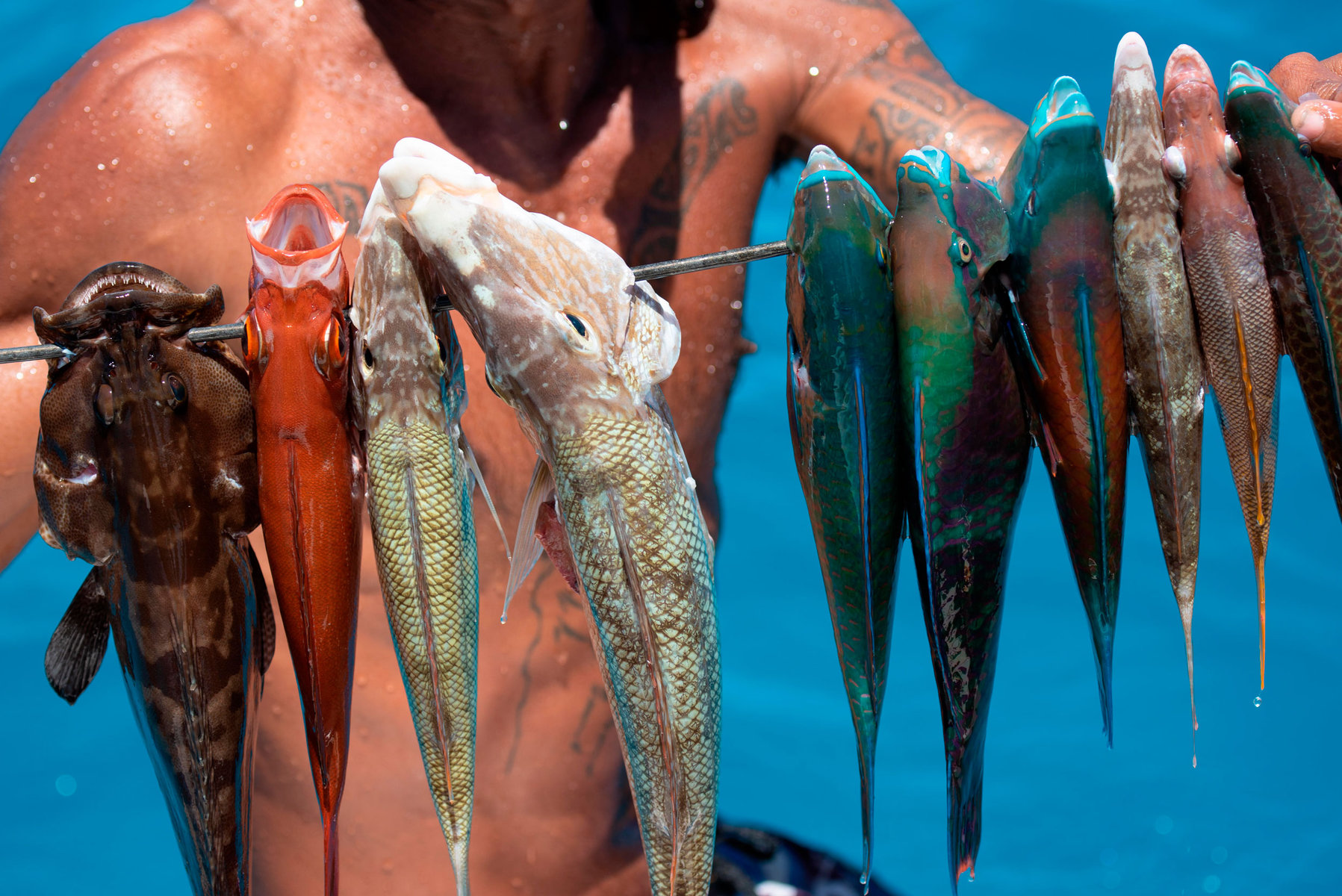This story was originally published by Hakai Magazine.
Located in a quiet part of Tahiti, in French Polynesia, the village of Tautira sits on the ocean’s edge, framed by black sand beaches and a turquoise lagoon. With a population of just over 2,500, Tautira is known as the “village at the end of the road.” Beyond it is the island’s last truly wild coastline, accessible only on foot or by boat. Tautira is the kind of place where everyone is a “cousin,” “aunty” or “uncle”; smiles are generous; and kids play soccer on the street. Some families here still live off the land, selling fish, fruits and vegetables by the road to make ends meet.
On a balmy day in May 2023, for the first time in four years, the lagoon in Tautira saw the return of its apex predator. A group of about 50 local fishers, armed with fishing lines and spearguns, gathered at the marina at midday and pulled out coolers laden with their catches: crimson-red, bulging-eyed blotcheye soldierfish; green-and-blue-hued parrotfish the length of a man’s arm, and unicornfish with their distinctive hornlike noses. Over two mornings, the fishers caught around one ton of fish — equal to more than 2,500 individual fish. Just five years ago, fishers would have been lucky to get that many fish in one week. The impressive catch was a testament to an ancient eastern Polynesian practice, known as rāhui, that might just be a key to developing sustainable, community-led solutions in Tahiti’s depleted coastal ecosystems.
A rāhui is, in essence, an area of land or water with a temporary limit on collecting a resource, such as a particular fish or fruit. In time, once the resource has had time to replenish, the rāhui is lifted. The word rāhui has many meanings in Polynesia. It can refer to a management system, a practice, a place, a belief, a law or a lens through which related actions are assessed.
The concept of rāhui has existed in Polynesia — the more than 1,000 islands from New Zealand in the southwest, to Hawai‘i in the north, to Tahiti in the southeast — since before Europeans arrived in the South Pacific. These islands share similar languages and cultures and enjoy a long history of trade and connection.

Yves Doudoute, Tahitian cultural expert and founding member of Haururu, an environmental conservation association, explains that in the Polynesian worldview, humans are an integral part of the natural environment: “For our ancestors, the Earth was the first. She was our mother. She was even like a god. So you had to respect her.”
Many Polynesian legends speak to this sacred connection to the environment. In Māori mythology, Papatūānuku (earth mother) and Ranginui (sky father) are ancestors of all living things; to Native Hawaiians, the taro plant, Kalo, is their older brother; and all Polynesians consider that people, objects or places can be imbued with mana, a kind of divine power or authority. A good leader, endowed with mana, had the power to create rāhui to manage resources.
Doudoute says that in the past, chiefs “were there to organize the management of everything. And so the rāhui was a form of management … but first, they would go to a god, to an all-powerful being, to intercede on their behalf, to help them in their endeavor.”
Divine authority sets the rāhui with the consent and collaboration of the people. It is a form of conservation, but it also serves many other, perhaps more important, purposes, such as to boost political power, strengthen community relationships and reaffirm religious rituals. Rāhui is a fluid system that can adapt to different communities and perform a wide variety of functions.
Today, a resurgence of rāhui in Polynesia, such as the one initiated on Tautira in 2019, is showing how culturally sensitive conservation that engages locals has the potential to create lasting change. A 2019 study by the Pew Bertarelli Ocean Legacy Project found that 90 percent of inhabitants in French Polynesia support rāhui, much higher than the support for other legal conservation methods like protected marine areas.
The first modern rāhui in French Polynesia began on the island of Rapa, one of the most isolated islands in the Austral archipelago, accessible only by boat and with a population of around 500 people. On the island, fishing is one of the main sources of food and income.
By the early 1980s, local fishers and residents in Rapa had noticed that fish numbers were decreasing, and the fish themselves were getting smaller. New methods such as net fishing and the arrival of technologies such as freezers and motorized boats changed the way islanders interacted with the ocean. Lionel Watanabe, a former mayor, noted that by 1984, mullet fish had almost disappeared in the island’s main bay. Watanabe was inspired by a trip to Hawai‘i, where he visited Hanauma Bay Nature Reserve in Honolulu. The reserve had become an official marine-life conservation area with strict limits on fishing. Watanabe returned home determined to create something similar in Rapa.
The mayor decided to resurrect the old system of rāhui, but adapted to the modern day. Some local fishers were skeptical and pushed back. They argued against the plan, worried that the rāhui might affect their livelihoods. While the community knew that fish numbers had declined, everyone had their own opinion on how to tackle the problem. Countless hours of community meetings and compromises eventually led to an agreement, and a coastal rāhui was officially implemented in 1984, encompassing the island’s biggest bay, Ahurei. The entire bay became a closed zone, where spearfishing and night fishing were banned, but line and harpoon fishing — techniques considered more sustainable — were permitted. The community banned net fishing and cage trapping of lobsters everywhere, including in the “open zone” outside of the bay, where there were fewer restrictions.